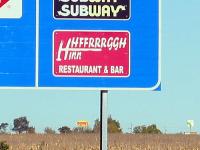Originally posted July 21, 2006. See below for an update!
Not unlike Charles Foster Kane’s plaintive deathbed whisper — “Rosebud!” — I awoke this morning with one word in my brain (though fortunately for my surely-to-be-perplexed wife, I did not utter it aloud)… “Haystacks!”
Not a literal stack of hay, mind you, but a particular type of candy my grandfather adored (for some inexplicable reason); one I haven’t seen in years, if not decades.
The haystack is a peculiar candy. Start with a mound of a mysterious white sugary substance, the most cloyingly, sickeningly, tooth-rottingly sweet concoction you can imagine. Form it into the vaguely parabolic shape of a haystack (hence the name), and cover it in chocolate.
I think Brach’s used to sell these in cellophane bags, along with dozens of other kinds of candy not enjoyed by anyone born after 1929. But my grandfather used to buy his in bulk at a fresh produce market (that also had a greenhouse and a large bulk candy section), improbably located in Mapleview, Minnesota.
In attempting to locate more information about these candies, I was reminded of two things: 1) There’s another, completely unrelated (although much more accurately describable as “haystacks”) type of candy involving butterscotch, peanut butter, and chow mein noodles, and 2) although my grandfather, and by extension my parents, called them “haystacks,” I think Brach’s and Super Fresh Produce actually called them something else.
And so, I am brought back to Citizen Kane. Like Charles Foster, I am probably destined to live my entire adult life never to relive certain childhood memories. Unlike Mr. Kane, however, I doubt it will lead to any deathbed regrets.
Addendum (July 21, 2006): I was simultaneously validated in my memory and pigeonholed geographically and culturally by this discovery. In my various and relatively fruitless (not to mention pointless) Google searches to try to get an answer, I found a reference in a post on the Prairie Home Companion message boards to the candies I’m talking about, even calling them “haystacks,” distinctly different from every other type of “haystack” candy I’ve so far found online, all of which seem to contain coconut, chow mein noodles, or shoestring potatoes. Not at all what I remember, though I will happily concede that they do much more closely resemble actual haystacks.
Update (August 26, 2006): I guess it’s good that my parents read this after all! They informed me today that the “other” name for these candies is chocolate cream drops. A fine example of what they look like can be seen at the Vermont Country Store website, where you can even order the godawful things if you want. Knock yourself out. If you’re just interested in more pictures (recommended) rather than actually tasting them, you can also see some examples at the Spangler Candy (archrival to Brach’s in the inedible candy wars) website or, strangely, on a site called Smokes-Spirits.com (which, after further consideration, I guess makes sense, considering the only way you can stand to eat these things is if your sense of taste is numbed by alcohol or a 2-pack-a-day habit).
 Even though I love all things Google (and, more and more, Google is all things), I have always hated their logo. Ugly font, garish colors, outdated-five-years-ago Photoshop 101 effects (Bevel & Emboss… Drop Shadow… how original!).
Even though I love all things Google (and, more and more, Google is all things), I have always hated their logo. Ugly font, garish colors, outdated-five-years-ago Photoshop 101 effects (Bevel & Emboss… Drop Shadow… how original!).
